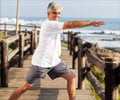Three or four one-minute bursts of activity during daily tasks are associated with reductions in the risk of premature death
- Three to four bouts of 60 seconds of vigorous intermittent lifestyle physical activity (VILPA) can prolong your life by reducing the risk of premature death
- VILPA is linked to a dramatic 40% drop in all-cause and cancer-related deaths, as well as a 49% reduction in heart disease-related deaths //
- Physical activity guidelines must incorporate VILPA to promote good health
Health Benefits of Exercise
Go to source).
VILPA refers to very short bursts of vigorous activity (up to one to two minutes) that we do with zeal every day, such as running for the bus, power walking while running errands, or playing high-energy games with the kids.
The researchers discovered that just three to four one-minute bouts of VILPA per day are associated with a 40% reduction in all-cause and cancer-related mortality, and a 49% reduction in death from cardiovascular disease.
"Our study shows similar benefits to high-intensity interval training (HIIT) can be achieved by increasing the intensity of incidental activities done as part of daily living, and the more the better," said lead author Emmanuel Stamatakis, Professor of Physical Activity, Lifestyle, and Population Health at the University of Sydney's Charles Perkins Centre.
"A few very short bouts totaling three to four minutes a day could go a long way, and there are many daily activities that can be tweaked to raise your heart rate for a minute or so".
"Upping the intensity of daily activities requires no time commitment, no preparation, no club memberships, and no special skills; it simply involves stepping up the pace while walking or doing the housework with a bit more energy," he said.
Importance of VILPA in Daily Life
VILPA was performed by approximately 89 percent of all participants.However, larger VILPA amounts resulted in greater benefits, implying that the more, the better. When compared to no VILPA, a maximum of 11 bouts per day were associated with a 66% reduction in cardiovascular death risk and a 49% reduction in cancer-related death risk.
Surprisingly, a comparison of the vigorous activity of 62,000 people who regularly exercised yielded comparable results. This means that whether the vigorous activity is done as part of structured exercise or as housework, the health benefits are not compromised.
Researchers used wrist-worn tracker data from UK Biobank, a large-scale biomedical database, to measure the activity of over 25,000 'non-exercisers,' or people who self-reported that they do not participate in sports or exercise in their spare time.
Using this method, the researchers were able to conclude that any activity recorded by this group was incidental physical activity performed as part of daily life.
The team then gained access to health data, allowing them to follow participants for seven years.
The studies are observational, which means that they cannot establish cause and effect. However, the researchers used rigorous statistical measures to reduce the possibility that the results were explained by differences in participants' health status.
"These findings demonstrate just how valuable detailed and objective measures of physical activity can be when collected on a large-scale population. We are incredibly grateful to all of the 100,000 UK Biobank participants who wore an activity monitor for 7 days to generate these valuable data," said Professor Naomi Allen, Chief Scientist of UK Biobank.
Guidelines for Physical Activity Must be Updated
According to current global guidelines, the health benefits of vigorous-intensity physical activity are obtained through structured physical activity during leisure time, such as sports or running.Only in 2020 did the WHO global guidelines on physical activity and sedentary behavior, co-chaired by Professor Stamatakis, recognize that "all activity counts," and the requirement that activity be accumulated in 10-minute bouts was removed.
"Our previous knowledge about the health benefits of vigorous physical activity comes from questionnaire-based studies, but questionnaires cannot measure short bouts of any intensity," said Professor Stamatakis.
"The ability of wearable technology to reveal "micropatterns" of physical activity, such as VILPA, holds huge potential for understanding the most feasible and time-efficient ways people can benefit from physical activity, no matter whether it is done for recreation or as part of daily living."
Hence, the physical activity guidelines can be reformed, and activities like VILPA can be included to improve one’s health.
Reference:
- Health Benefits of Exercise - (https://pubmed.ncbi.nlm.nih.gov/28507196/)
Source-Medindia
















